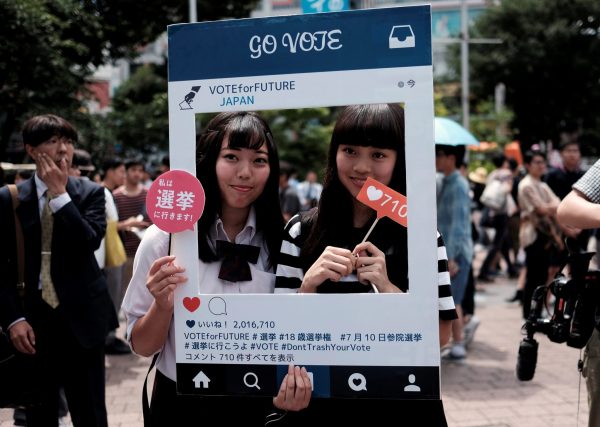According to a survey conducted by the Asahi Shimbun in December 2008, 57 per cent of respondents disagreed with lowering the voting age, while only 38 per cent agreed. The remaining chose not to answer. When the same survey was repeated in March 2015, the percentage of respondents who agreed increased to 48 per cent, while the percentage of those who disagreed fell to 39 per cent.
While public perception toward the change may be shifting, how has the lowered voting age affected voting trends?
First, we looked at voter turnout. During the House of Councillors election in 2016 — the first national election for 18- and 19-year-olds — the overall voter turnout was 54.7 per cent. For 188 of the 47,905 voting districts, the voting rate was 51.17 per cent for 18-year-olds and 39.66 per cent for 19-year-olds. The turnout of 18-year-olds was higher than the 50.30 per cent turnout rate of those aged 40 to 44, while the turnout of 19-year-olds was higher than the 37.91 per cent turnout rate of those aged 25 to 29. The 33.21 per cent turnout rate of those aged 20 to 24 was the lowest of all age brackets.
In short, 18-and 19-year-olds did well in terms of voter turnout.
Second, we determined the effect on the percentage of invalid votes. The average invalid voting rate over the past three House of Councillors elections was 2.88 per cent, whereas this time it was 2.65 per cent. So the invalid voting rate decreased for the electoral districts. Conversely, the average number of invalid votes for proportional representation districts increased over the past three elections, from 2.98 per cent to 3.57 per cent.
For the 9 prefectural governor elections that followed the recent upper house election, the percentage of invalid votes decreased in five (Tochigi, Chiba, Tokyo, Niigata, Okayama), increased in three (Shizuoka, Hyogo, Kagoshima) and remained the same in one (Gifu). Overall, despite increases in some districts, lowering the voting age has not increased the number of invalid votes.
When politicians lowered the voting age, some related action was required. In order to instil in this new age group effective voter skills, the government created auxiliary teaching materials and distributed these to third-grade students at all high schools. These materials included practical approaches — such as interactive discussions on political issues, and simulated voting and petition exercises — to supplement more theoretical explanations of campaigns and the electoral system.
According to a survey by the Ministry of Education, 94.4 per cent of all high schools in Japan offered political education for third-graders in 2015. The educational content included: ‘Learning the public offices election law and election system’ (89.4 per cent), ‘Discussion activities on real politics’ (20.9 per cent), and ‘Activities such as simulated elections’ (29.0 per cent).
Unfortunately, the practical activities were not actively utilised due to difficulties in securing neutrality when debating political issues, increased burdens on teachers to prepare and the limited time and space available in the curriculum to devote to political education.
The reduced voting age has given the younger generation the opportunity to express their voice. If politicians recognise that this generation is politically engaged, they will be inclined to address policy issues affecting them. There are already some examples of this. A new ‘benefit-type scholarship’ for college students was established in 2017 that does not need to be repaid. And the Abe Cabinet is also considering making education free of charge.
What’s more, the proportion of 18-year-olds accompanying parents to polling stations is high, which could have the added effect of revitalising parents’ motivation to vote.
But the lowered voting age has also revealed various inadequacies in Japan’s political education system, particularly its focus on theoretical rather than practical teachings. The low turnout rate among those in their 20s also stands out and suggests that it is necessary to consider civic education in universities as well.
Lowering the voting age has given us a chance to think about what political skills we should be acquiring and how we can transfer these skills to children. A long-standing commitment to improving civic education is required in order to make the most of this new opportunity.
Miho Nakatani is Associate Professor in the Faculty of Law, Meiji Gakuin University.

